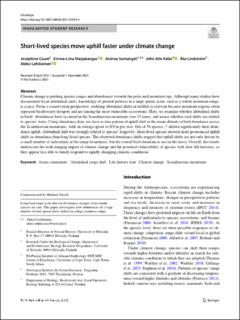| dc.contributor.author | Couet, Joséphine | |
| dc.contributor.author | Marjakangas, Emma‑Liina | |
| dc.contributor.author | Santangeli, Andrea | |
| dc.contributor.author | Kålås, John Atle | |
| dc.contributor.author | Lindström, Åke | |
| dc.contributor.author | Lehikoinen, Aleksi | |
| dc.date.accessioned | 2022-08-08T11:22:24Z | |
| dc.date.available | 2022-08-08T11:22:24Z | |
| dc.date.created | 2022-01-10T14:56:26Z | |
| dc.date.issued | 2022 | |
| dc.identifier.issn | 0029-8549 | |
| dc.identifier.uri | https://hdl.handle.net/11250/3010623 | |
| dc.description.abstract | Climate change is pushing species ranges and abundances towards the poles and mountain tops. Although many studies have documented local altitudinal shifts, knowledge of general patterns at a large spatial scale, such as a whole mountain range, is scarce. From a conservation perspective, studying altitudinal shifts in wildlife is relevant because mountain regions often represent biodiversity hotspots and are among the most vulnerable ecosystems. Here, we examine whether altitudinal shifts in birds’ abundances have occurred in the Scandinavian mountains over 13 years, and assess whether such shifts are related to species’ traits. Using abundance data, we show a clear pattern of uphill shift in the mean altitude of bird abundance across the Scandinavian mountains, with an average speed of 0.9 m per year. Out of 76 species, 7 shifted significantly their abundance uphill. Altitudinal shift was strongly related to species’ longevity: short-lived species showed more pronounced uphill shifts in abundance than long-lived species. The observed abundance shifts suggest that uphill shifts are not only driven by a small number of individuals at the range boundaries, but the overall bird abundances are on the move. Overall, the results underscore the wide-ranging impact of climate change and the potential vulnerability of species with slow life histories, as they appear less able to timely respond to rapidly changing climatic conditions. Avian community · Altitudinal range shift · Life-history trait · Climate change · Scandinavian mountains | en_US |
| dc.language.iso | eng | en_US |
| dc.rights | Navngivelse 4.0 Internasjonal | * |
| dc.rights.uri | http://creativecommons.org/licenses/by/4.0/deed.no | * |
| dc.title | Short‑lived species move uphill faster under climate change | en_US |
| dc.type | Peer reviewed | en_US |
| dc.type | Journal article | en_US |
| dc.description.version | publishedVersion | en_US |
| dc.rights.holder | © 2022 The Authors | en_US |
| dc.subject.nsi | VDP::Økologi: 488 | en_US |
| dc.subject.nsi | VDP::Ecology: 488 | en_US |
| dc.source.journal | Oecologia | en_US |
| dc.identifier.doi | 10.1007/s00442-021-05094-4 | |
| dc.identifier.cristin | 1977695 | |
| dc.relation.project | Andre: Academy of Finland (projects 307909 and 323527) | en_US |
| dc.relation.project | Andre: Academy of Finland (Helsinki: 326338) | en_US |
| dc.relation.project | Miljødirektoratet: The national terrestrial monitoring program (TOV) | en_US |
| dc.relation.project | Klima- og miljødepartementet: The national terrestrial monitoring program (TOV) | en_US |
| dc.relation.project | Andre: Swedish FORMAS Research Council (Lund: 2018–02441) | en_US |
| cristin.ispublished | true | |
| cristin.fulltext | original | |
| cristin.qualitycode | 2 | |

